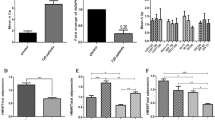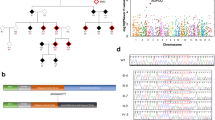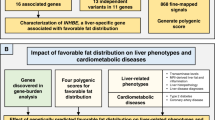Abstract
BACKGROUND: Adiponectin is a collagen-like plasma protein specifically synthesized in adipose tissue. Plasma adiponectin concentrations are decreased in obesity whereas it is adipose-specific.
OBJECTIVE: To clarify the significance of the genetic variations in adiponectin gene on its plasma concentrations and obesity.
SUBJECTS: Two hundred and nineteen unrelated adult Japanese subjects (123 men and 96 women, age: 20–83 y, BMI: 16–43 kg/m2) including 77 obese subjects (BMI>26.4 kg/m2).
MEASUREMENT: Human adiponectin gene was isolated from PAC DNA pools. Mutations in the adiponectin gene were screened by direct sequencing or restriction-fragment polymorphism. The levels of plasma adiponectin were determined by the enzyme-linked immunosorbent assay (ELISA).
RESULTS: Adiponectin gene spanned 17 kb on chromosome 3q27, consisting of three exons and two introns. Within 2.1 kb of the 5′-flanking region, there were two octamer elements present in the promoter of adipsin. Two nucleotide changes were identified. One was a polymorphism (G/T) occurring in exon 2, and the other was a missense mutation (R112C) in exon 3. The mean plasma adiponectin levels of the subjects carrying G allele were low (G/G: 4.5 μg/ml; G/T: 5.9 μg/ml; and T/T: 6.3 μg/ml), but were not statistically significant. The allelic frequency between the obese and the non-obese showed no significant difference. The subject carrying R112C mutation showed markedly low concentration of plasma adiponectin.
CONCLUSION: Two nucleotide changes have been identified in the adiponectin gene. G/T polymorphism in exon 2 was associated with neither plasma adiponectin concentrations nor the presence of obesity. A subject carrying missense mutation (R112C) showed markedly low plasma adiponectin concentration.
This is a preview of subscription content, access via your institution
Access options
Subscribe to this journal
Receive 12 print issues and online access
$259.00 per year
only $21.58 per issue
Buy this article
- Purchase on SpringerLink
- Instant access to full article PDF
Prices may be subject to local taxes which are calculated during checkout





Similar content being viewed by others
References
Funahashi T, Nakamura T, Shimomura I, Macda K, Kuriyama H, Takahashi M, Arita Y, Kihara S, Matsuzawa Y . Role of adipocytokines on the pathogenesis of atherosclerosis in visceral obesity Intern Med 1999 38: 202–206.
Shimomura I, Funahashi T, Takahashi M, Maeda K, Kotani K, Nakamura T, Yamashita S, Miura M, Fukuda Y, Takemura K, Tokunaga K, Matsuzawa Y . Enhanced expression of PAI-1 in visceral fat: possible contributor to vascular disease in obesity Nature Med 1996 2: 800–802.
White RT, Damm D, Hancock N, Rosen BS, Lowell BB, Usher P, Flier JS, Spiegelman BM . Human adipsin is identical to complement factor D and is expressed at high levels in adipose tissue J Biol Chem 1992 267: 9210–9213.
Hotamisligil GS, Arner P, Caro JF, Atkinson RL, Spiegelman BM . Increased adipose tissue expression of tumor necrosis factor-alpha in human obesity and insulin resistance J Clin Invest 1995 95: 2409–2415.
Zhang Y, Proenca R, Maffei M, Barone M, Leopold L, Friedman JM . Positional cloning of the mouse obese gene and its human homologue Nature 1994 372: 425–432.
Maeda K, Okubo K, Shimomura I, Funahashi T, Matsuzawa Y, Matsubara K . cDNA cloning and expression of a novel adipose specific collagen-like factor, apM1 (adipose most abundant gene transcript 1) Biochem Biophys Res Commun 1996 221: 286–289.
Arita Y, Kihara S, Ouchi N, Takahashi M, Maeda K, Miyagawa J, Hotta K, Shimomura I, Nakamura T, Miyaoka K, Kuriyama H, Nishida M, Yamashita S, Okubo K, Matsubara K, Muraguchi M, Ohmoto Y, Funahashi T, Matsuzawa Y . Paradoxical decrease of an adipose-specific protein, adiponectin, in obesity Biochem Biophys Res Commun 1999 257:: 79–83.
Horie M, Okutomi K, Taniguchi Y, Ohbuchi Y, Suzuki M, Takahashi E . Isolation and characterization of a new member of the human Ly6 gene family (LY6H) Genomics 1998 53: 365–368.
Reichenberger E, Beier F, Valle PL, Olsen BR, Mark K, Bertling WB . Genomic organization and full-length cDNA sequence of human collagen X FEBS Lett 1992 311:: 305–310.
Shapiro MB, Senapathy P . RNA splice junctions of different classes of eukaryotes: sequence statistics and functional implications in gene Nucleic Acids Res 1987 15: 7155–7174.
Schaffler A, Langmann T, Palitzsch K-D, Scholmerich J, Schmitz G . Identification and characterization of the human adipocyte apM-1 promoter Biochim Biophys Acta 1998 1399: 187–197.
Phillips M, Djian P, Green H . The nucleotide sequence of three genes participating in the adipose differentiation of 3T3 cells J Biol Chem 1986 261: 10821–10827.
Mitchell PJ, Tjian R . Transcriptional regulation in mammalian cells by sequence-specific DNA binding proteins Science 1986 245: 371–378.
Flier J S, Cook KS, Usher P, Spiegelman BM . Severely impaired adipsin expression in genetic and acquired obesity Science 1987 237: 405–408.
Platt KA, Claffey KP, Wilkison WO, Spiegelman BM, Ross SR . Independent regulation of adipose tissue-specificity and obesity response of the adipsin promoter in transgenic mouse J Biol Chem 1994 269: 28558–28562.
Gurney AL, Kuang WJ, Xie MH, Malloy BE, Eaton DL, Sauvage F . Genomic structure, chromosomal localization, and conserved alternative splice forms of thrombopoietin Blood 1995 85: 981–988.
Takada F, Seki N, Matsuda Y, Takayama Y, Kawakami M . Localization of the genes for the 100-kDa complement-activating components of Ra-reactive factor (CRARF and Crarf) to human 3q27-q28 and mouse 16B2-3 Genomics 1995 25: 757–759.
Jokiaho I, Salo A, Niemi KM, Blomstedt GC, Pihikala J . Deletion 3q27–3qter in an infant with mild dysmorphism, parietal meningocele, and neonatal miliaria rubra-like lesion Hum Genet 1989 83: 302–304.
Bastard C, Tilly H, Lenormand B, Bigorgne C, Boulet D, Kunlin A, Monconduit M, Piguet H . Translocations involving band 3q27 and Ig gene regions in non-Hodgkin's lymphoma Blood 1992 79: 2527–2531.
Rosenblum ND . Recombinant alpha 1 (VIII) collagen chains form homodimers in vitro Biochem Biophys Res Commun 1996 227: 205–210.
Sellar GC, Blake DJ, Reid KB . Characterization and organization of the genes encoding the A-, B- and C-chains of human complement subcomponent C1q Biochem J 1991 274:: 481–490.
Reid BM . Molecular cloning and characterization of the complementary DNA and gene coding for the B-chain of subcomponent C1q of the human complement system. Biochem J 1985 231: 729–735.
Hu E, Liang P, Spiegelman BM . AdipoQ is a novel adipose-specific gene dysregulated in obesity J Biol Chem 1996 271: 10697–10703.
Scherer EP, Williams S, Fogliano M, Baldini G, Lodish HF . A novel serum protein similar to C1q, produced exclusively in adipocytes J Biol Chem 1995 270: 26746–26749.
Napolitano A, Lowell BB, Damm D, Leibel RL, Ravussin E, Jimerson DC, Lesem MD, Dyke DCV, Daly PA, Chatis P, White RT, Spiegelman BM, Flier JS . Concentrations of adipsin in blood and rates of adipsin secretion by adipose tissue in humans with normal, elevated and diminished adipose tissue mass Int J Obes Relat Metab Disord 1994 18: 213–218.
Montague CT, Farooqi IS, Whitehead JP, Soos MA, Rau H, Wareham NJ, Sewter CP, Digby JE, Mohammed SN, Hurst JA, Cheetham CH, Earley AR, Barnett AH, Prins JB, O'Rahilly S . Congenital leptin deficiency is associated with severe early-onset obesity in humans Nature 1997 387: 903–908.
Ristow M, Muller-Wieland D, Pfeiffer A, Krone W, Kahn R . Obesity associated with a mutation in a genetic regulator of adipocyte differentiation N Engl J Med 1998 339:: 953–959.
Beamer BA, Yen CJ, Anderson RE, Muller D, Elahi D, Cheskin LJ, Andres R, Shuldiner AR . Association of the Pro 12 Ala variant in the peroxisome proliferator-activated receptor-gamma2 gene with obesity in two Caucasian populations Diabetes 1998 47: 1806–1808.
Koch M, Rett K, Maerker E, Volk A, Haist K, Deninger M, Renn W, Haring HU . The PPARgamma2 amino acid polymorphism Pro 12 Ala is prevalent in offspring of type II diabetic patients and is associated to increased insulin sensitivity in a subgroup of obese subjects Diabetologia 1999 42: 758–762.
Ringel J, Engeli S, Distler A, Sharma AM . Pro 12 Ala missense mutation of the peroxisome proliferator activated receptor gamma and diabetes mellitus Biochem Biophys Res Commun 1999 254: 450–453.
Mancini FP, Vaccaro O, Sabatino L, Tufano A, Rivellese AA, Riccardi G, Colantuoni V . Pro 12 Ala substitution in the peroxisome proliferator-activated receptor-gamma2 is not associated with type 2 diabetes Diabetes 1999 48:: 1466–1468.
Hamann A, Muzberg H, Buttron P, Busing B, Hinney A, Mayer H, Siegfried W, Hebebrand J, Greten H . Missense variants in the human peroxisome proliferator-activated receptor-gamma2 gene in lean and obese subjects Eur J Endocrinol 1999 141: 90–92.
Cooper DN, Youssoufian H . The CpG dinucleotide and human genetic disease Hum Genet 1988 78: 151–155.
Peake PW, O'Grady S, Pussell BA, Charlsworth JA . Detection and quantification of the control proteins of the alternative pathway of complement in 3T3-L1 adipocytes Eur J Clin Invest 1997 27: 922–927.
Choy LN, Spiegelman BM . Regulation of altanative pathway activation and C3a production by adipose cells Obes Res 1996 4: 521–532.
Cianflone K, Maslowska M, Sniderman AD . Acylation stimulating protein (ASP), an adipocyte autocrine: new directions Semin Cell Devl Biol 1999 10: 31–41.
Ouchi N, Kihara S, Arita Y, Maeda K, Kuriyama H, Okamoto Y, Hotta K, Nishida M, Takahashi M, Nakamura T, Yamashita S, Funahashi T, Matsuzawa Y . Novel modulator for endothelial adhesion molecules: adipocyte-derived plasma protein, adiponectin Circulation 1999 100: 2473–2476.
Acknowledgements
This work was supported in part by a ‘Research for the Future’ Program from The Japan Society for the Promotion of Science: JSPS-RFTF97L00801 and Grants-in-Aid from the Ministry of Education, Science, Sports and Culture of Japan (09307019, 10557100, 10557101, 10671035).
Author information
Authors and Affiliations
Corresponding author
Rights and permissions
About this article
Cite this article
Takahashi, M., Arita, Y., Yamagata, K. et al. Genomic structure and mutations in adipose-specific gene, adiponectin. Int J Obes 24, 861–868 (2000). https://doi.org/10.1038/sj.ijo.0801244
Received:
Revised:
Accepted:
Published:
Issue Date:
DOI: https://doi.org/10.1038/sj.ijo.0801244



